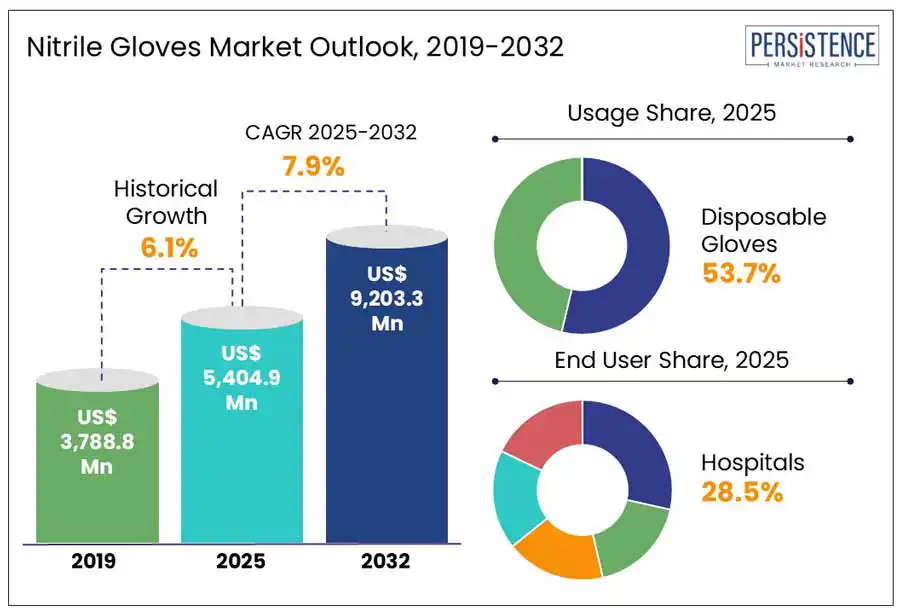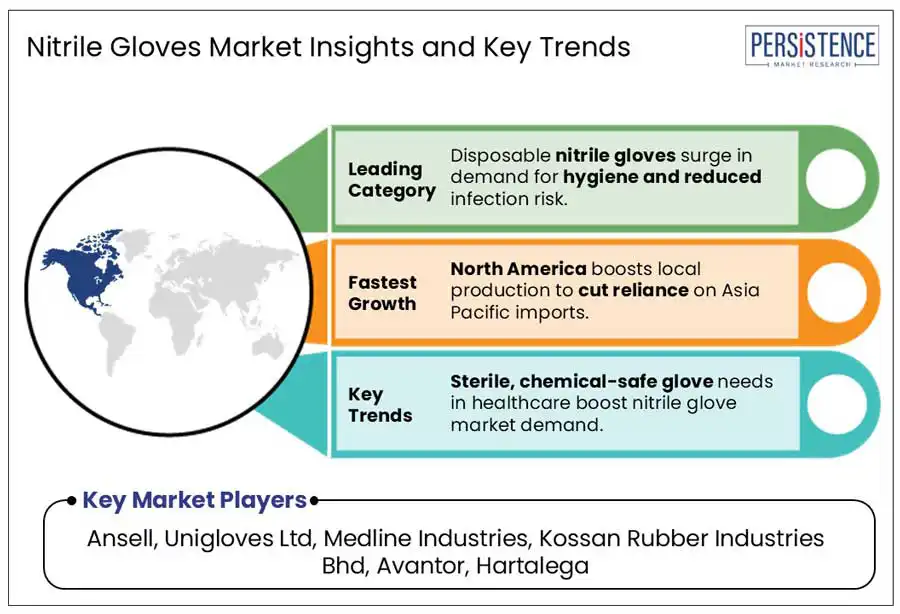Comprehensive Snapshot for Nitrile Gloves Market Including Regional and Country Analysis in Brief.
Industry: Chemicals and Materials
Published Date: April-2025
Format: PPT*, PDF, EXCEL
Delivery Timelines: Contact Sales
Number of Pages: 180
Report ID: PMRREP31892
The global nitrile gloves market size is projected to rise from US$ 5,404.9 Mn in 2025 to US$ 9,203.3 Mn to witness a CAGR of 7.9% by 2032. The implementation of strict government norms regarding the safety of doctors, patients, and other healthcare workers across hospitals and clinics is expected to propel nitrile glove demand. Employers are projected to seek these gloves to protect their staff from several health hazards and infections due to huge fines for non-compliance with safety standards.

Key Industry Highlights
|
Global Market Attribute |
Key Insights |
|
Nitrile Gloves Market Size (2025E) |
US$ 5,404.9 Mn |
|
Market Value Forecast (2032F) |
US$ 9,203.3 Mn |
|
Projected Growth (CAGR 2025 to 2032) |
7.9% |
|
Historical Market Growth (CAGR 2019 to 2024) |
6.1% |
Increasing prevalence of infectious and chronic diseases globally is predicted to be a key market growth driver. The volume of routine check-ups, diagnostic testing, surgical procedures, and patient monitoring is rising as patients prefer medical care for contagious and long-term illnesses. This needs healthcare professionals to change gloves frequently to counter infection control standards and prevent cross-contamination.
Chronic ailments such as cardiovascular disorders, cancer, and diabetes are witnessing a surge worldwide. The World Health Organization (WHO) mentioned that around 74% of all deaths globally are a result of non-communicable diseases. Patients living with these conditions often require regular dialysis, wound care, blood tests, catheter insertions, and injections. Each of these procedures necessitates the utilization of medical-grade nitrile gloves.
Volatility in raw material prices is estimated to be a significant restraint. It is especially evident for acrylonitrile and butadiene as these are derived from crude oil. As nitrile gloves are made from synthetic rubber, fluctuations in oil prices globally directly affect production costs.
From 2021 to 2022, fluctuations in crude oil prices resulted in a 20% surge in nitrile rubber costs, which created a lot of pressure on profit margins of manufacturing companies. New entrants and small-scale companies often find it difficult to remain competitive, mainly when procurement contracts are short-term and prices are unpredictable.
Rapid expansion of the elderly care and home healthcare sector globally is anticipated to create lucrative opportunities through 2032. The sector is constantly developing due to rising patient preferences for in-home care, high healthcare costs, and demographic shifts. In these home-based healthcare settings, where infection control is crucial but frequently less controlled than in hospitals, nitrile gloves are indispensable.
Caregivers, including family members and professionals, are likely to use these gloves for tasks such as assisting with toileting and mobility, changing dressings, catheter care, or administering injections. These tasks demand gloves that are not only safe and durable but also comfortable and easy to use for long periods. To capitalize on this trend, several companies such as McKesson and Medline have launched multi-purpose nitrile gloves in small packaging online, mainly for home caregivers.
Ongoing expansion of glove production capacity and rising adoption of automation are a few leading trends in the market. Malaysia, for example, accounts for more than 60% of the nitrile glove supply worldwide. Key companies in the country such as Kossan Rubber Industries, Hartalega, and Top Glove have invested huge sums in automated production lines. For instance,
Automation is also expected to be an ideal solution for labor-related scrutiny and sanction. The U.S. Customs and Border Protection (CBP) banned imports from a few glove manufacturers based in Malaysia in 2021 due to forced labor claims. This compelled companies such as Top Glove to lower dependency on manual tasks and enhance labor conditions by using smart robotics.
By usage, the market is bifurcated into disposable and reusable gloves. Out of these, the disposable segment is projected to lead by holding a nitrile gloves market share of around 53.7% in 2025. It is attributed to increasing demand across healthcare facilities where maintaining cleanliness and hygiene standards is mandatory.
Reusable gloves are often considered inappropriate for use in these settings due to the potential risk of contamination. Though reusable gloves provide various benefits such as low waste generation, high durability, and superior strength, their use is anticipated to remain average in the healthcare sector. Instead, these are likely to find extensive use in heavy-duty work environments, including metal and machinery, automotive, and chemicals industries.
In terms of end-user, the market is divided into hospitals, ambulatory surgical centers, clinics, and diagnostic centers. Among these, hospitals are expected to generate about 28.5% share in 2025. Demand is predicted to rise due to the ability of nitrile gloves to resist infectious agents, chemicals, and punctures. In hospitals, the exposure to hazardous drugs and bloodborne pathogens is frequent. Hence, these gloves provide a strong barrier.
Diagnostic centers, on the other hand, are poised to seek nitrile gloves as these have excellent tactile sensitivity and chemical resistance. Both properties are considered important for handling diagnostic instruments, reagents, and biological samples. These labs also work with potentially infectious materials such as tissue biopsies, sputum, urine, and blood. Nitrile gloves help provide protection against these materials, keeping healthcare workers safe.

North America is anticipated to account for a share of nearly 38.6% in 2025, says Persistence Market Research. It is primarily propelled by a rising focus on infection control and stringent safety norms revolving around the healthcare sector. The region is predicted to be dominated by the U.S. nitrile gloves market through 2032.
The Occupational Safety and Health Administration (OSHA) and the U.S. Food and Drug Administration (FDA) have mandated the use of high-grade gloves such as nitrile gloves in clinical environments, spurring demand. In Canada, healthcare facilities are inclining toward nitrile over latex gloves due to better chemical resistance and allergy concerns. Both countries are estimated to invest in domestic manufacturing to lower dependency on international products.
In Asia Pacific, Malaysia is poised to showcase steady growth from 2025 to 2032. This is due to the presence of several leading manufacturers in the country. During the COVID-19 pandemic, in 2020 alone, Malaysia exported around 280 Bn gloves and among these, the majority were nitrile. Companies in Indonesia and Thailand are also extending production lines to shift away from gloves made of latex.
China and India, on the other hand, are likely to be the emerging markets. In India, the government is focusing on promoting domestic production under the ‘Make in India’ initiative. China is showcasing expansion of pharmaceutical and diagnostic sectors, which is poised to create a rising demand for nitrile gloves.
Stringent environmental and hygiene standards are anticipated to boost demand in Europe in the foreseeable future. Germany will likely outpace the other countries due to its extensive hospital networks that heavily rely on nitrile gloves. As per studies, in 2022, the country imported more than 15 Bn disposable nitrile gloves.
Spain, Italy, and France are expected to be significant markets through 2032. Public health institutions in these countries are gradually inclining toward nitrile gloves owing to European Union (EU) procurement guidelines. Nitrile gloves have superior barrier protection properties and can comply with EN 374 as well as EN 455 standards, which is pushing demand.
The global nitrile gloves market consists of several well-established companies. They are focusing on new product launches, collaborations, and mergers and acquisitions to gain a competitive edge. They are also investing in enhancing the effectiveness of distribution and supply chain. A few companies are aiming to cut off harmful materials from production and are introducing sustainable materials to cater to eco-conscious clients.
|
Report Attribute |
Details |
|
Historical Data/Actuals |
2019 - 2024 |
|
Forecast Period |
2025 - 2032 |
|
Market Analysis Units |
Value: US$ Bn/Mn, Volume: As Applicable |
|
Geographical Coverage |
|
|
Segmental Coverage |
|
|
Competitive Analysis |
|
|
Report Highlights |
|
|
Customization and Pricing |
Available upon request |
By Product
By Usage
By Sterility
By End-user
By Region
To know more about delivery timeline for this report Contact Sales

The global market is projected to be valued at US$ 5,404.9 Mn in 2025.
Strict safety standards in the healthcare sector and rising awareness of infection control are the key market drivers.
The market is poised to witness a CAGR of 7.9% from 2025 to 2032.
Boom of home-based healthcare and adoption of automation in production lines are the key market opportunities.
Ansell, Unigloves Ltd, Medline Industries, and Kossan Rubber Industries Bhd are a few key players.